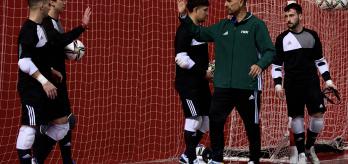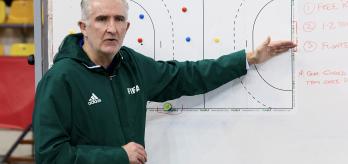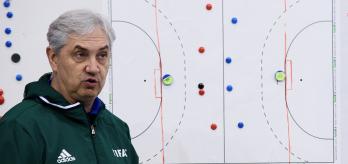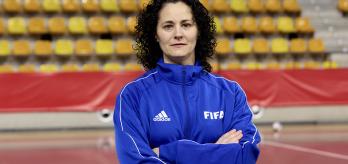Organisation
-
Use half of a court.
-
Place a goal at each end of the exercise area.
-
Position a goalkeeper in each goal.
-
Mark out a 2m x20m horizontal channel in the middle of the exercise area.
-
Place an attacker in the horizontal channel.
-
Arrange the remaining players in a queue on the touchline (level with the horizontal channel) and give each of them a ball.
Explanation
-
The exercise begins with the first player in the queue on the touchline playing a pass into the attacker positioned in the horizontal channel.
-
The attacker can attack either goal and has the following two options:
-
Take a first-time shot
-
Take a directional control that takes the ball beyond the horizontal channel to engage the goalkeeper in a 1v1 scenario. In this scenario, the attacker has 3 seconds within which to finish on goal.
-
If the goalkeeper claims the ball, they launch a counter-attack on the opposite goal by rolling the ball out of their penalty area and dribbling towards goal. The attacker who has just finished on goal becomes a defender and can drop back to defend the opposite goal but only once they have touched the marker positioned on the 5m line.
-
If the attacker scores, they stay on and receive another pass from the same server player.
-
If the attacker’s shot goes out of play, they join the back of the queue of players on the touchline, and the next attacker takes up a position in the horizontal channel.
Variations
-
Variation 1: Place three attackers in the horizontal channel and ask them to decide among themselves who will finish and if the finish is first-time or is preceded by a directional control.
-
Variation 2: The attacker has the option of setting up a team-mate for them to finish first-time from inside the penalty area.
-
If the goalkeeper catches the ball, they launch a counter-attack on the opposite goal. The last attacker to touch the ball drops back to defend, creating a counter-attack featuring a 2v1 overload.
Coaching point
-
Ask the goalkeepers to come off their line as soon as they identify that the attacker has chosen to control the ball rather than to finish first-time.































